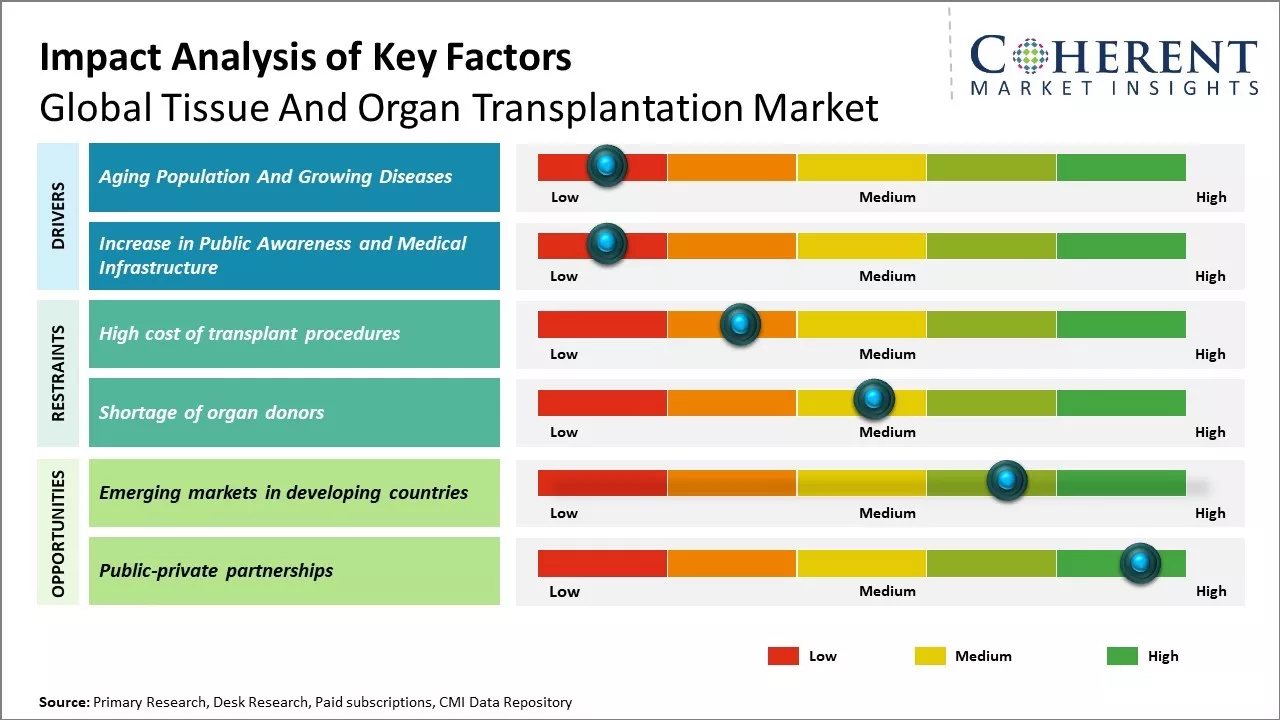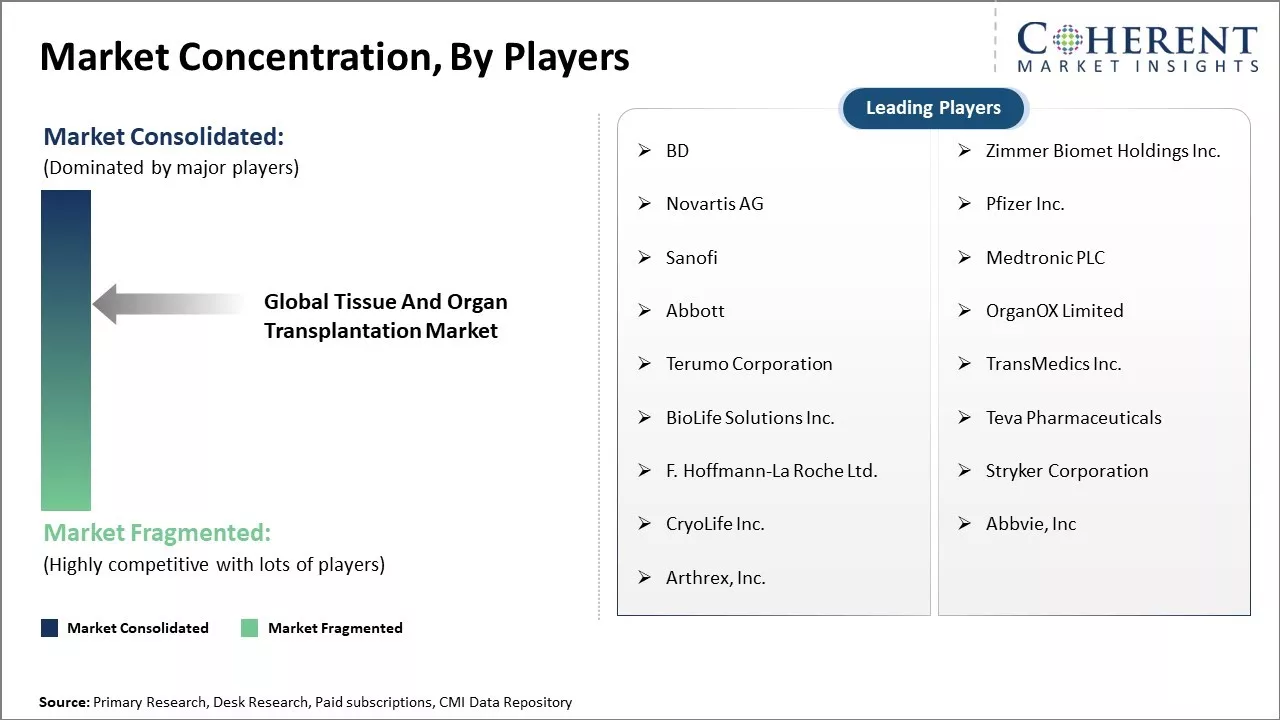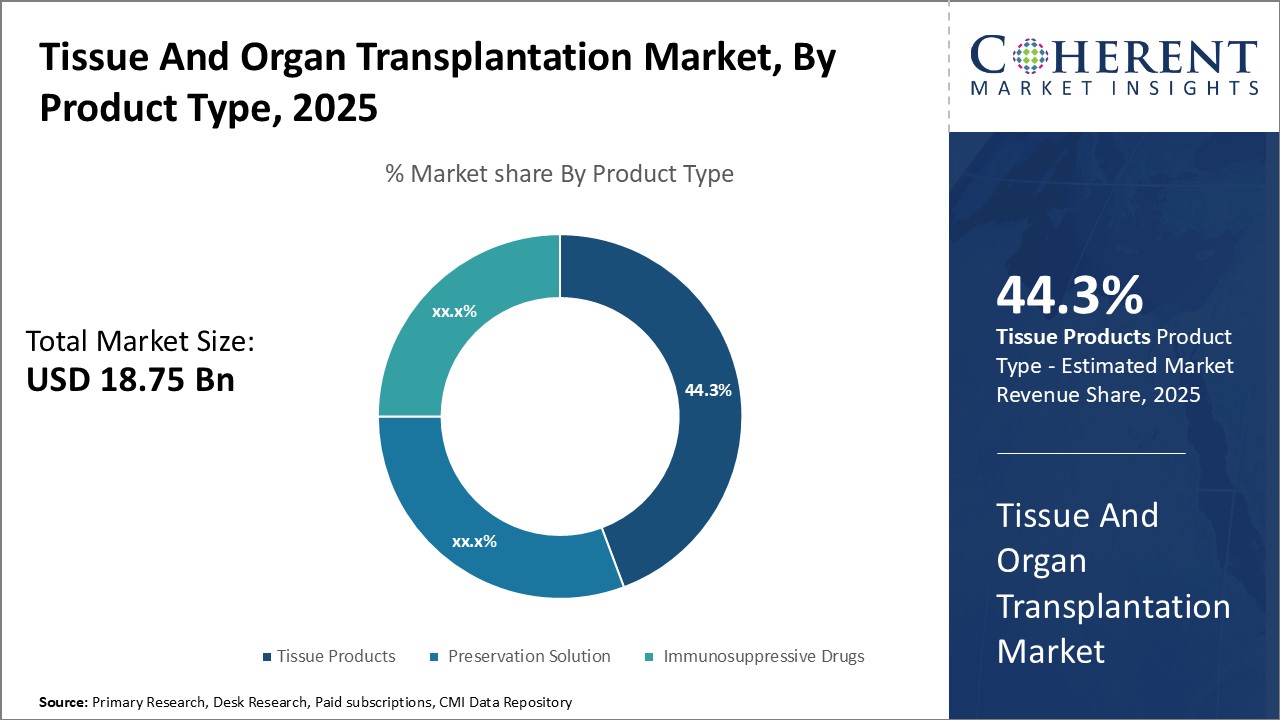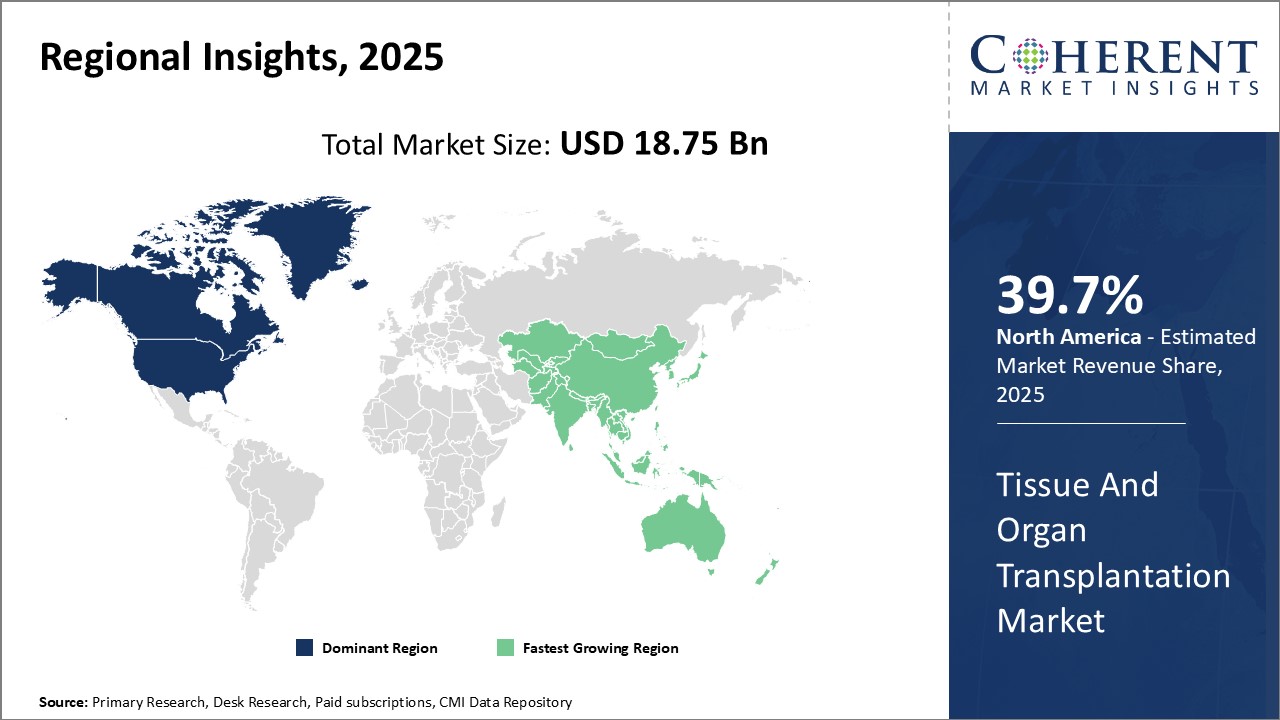Global tissue and organ transplantation market is estimated to be valued at USD 18.75 Bn in 2025 and is expected to reach USD 35.65 Bn by 2032, exhibiting a compound annual growth rate (CAGR) of 9.6% from 2025 to 2032.

Discover market dynamics shaping the industry: Download Free Sample
Growing prevalence of chronic diseases such as cancer, cardiovascular diseases, kidney diseases, and liver diseases boosts demand for tissue and organ transplantation procedures. Rising aging population worldwide also boosts demand for transplantation as aging increases the risk of developing health conditions that require tissue or organ transplant. Furthermore, technological developments in transplantation procedures and increased government funding & initiatives to promote organ donation can drive the global tissue and organ transplantation market during the forecast period.
Aging Population and Growing Diseases
Due to advancement in medical field, there has been increase in average life expectancy across the world. However, increasing age leads to several chronic diseases and health conditions that may damage vital organs beyond repair over time. Growing elderly population globally can lead to increase in cases of end-stage renal disease, cardiovascular failure, cancer, and other degenerative diseases, which can be treated by transplantation only. Modern unhealthy lifestyle practices causes younger people to develop cardiovascular and liver conditions earlier in their lives. Thus, there is huge demand for lifesaving organ transplantation procedures like kidney, heart, and liver transplants. According to some estimates, over 113,000 patients worldwide are currently in need of an organ transplant but very few matching donors are available. The healthcare industry and governments across nations are focusing more on bridging this gap between demand and supply to save more lives. For instance, according to the data published on World Kidney Day in March 2020, a collaboration between the International Society of Nephrology (ISN) and the International Federation of Kidney Foundations (IFKF), kidney disease affected approximately 850 million people worldwide. According to the Globocan 2020 report from the Global Cancer Observatory, a platform that estimates the incidence and mortality of 36 types of cancer across 185 countries, 19,292,789 new cases of cancer were diagnosed in 2020, resulting in approximately 9,958,133 deaths from cancer.

Get actionable strategies to beat competition: Download Free Sample
Increase in Public Awareness and Medical Infrastructure
Increasing awareness about organ donation and transplantation solutions among the general public as well as healthcare specialists can drive the market growth. Extensive education campaigns by non-profit organizations as well as hospitals have made more people understand the need and process of organ donation after death, which can then help many patients receive a second chance at life. Significant investments are being made by both public and private players to develop state-of-the-art transplant facilities with advanced medical equipment, expert surgeons, and streamlined logistics networks. This boosts organ transplantation success rates over the years. Advanced technologies like organ bio-printing can offer new possibilities and interest in this field. Governments across nations are also formulating supportive donation policies, reimbursement guidelines, and regulating the organ trade. All these factors helps patients to gain better access to transplantation therapies and drive the market growth.
Key Takeaways from Analyst:
Global tissue and organ transplantation market growth is driven by rising prevalence of chronic diseases and conditions requiring organ transplantation. Increasing adoption of new technologies like 3D bioprinting of tissues and organs can also drive the market growth. However, shortage of donors remains a significant challenge. Finding suitable donors is becoming more difficult with greater cultural and geographic diversity. High costs associated with transplantation procedures and lifelong medication regimen for recipients can hamper the market growth.
Asia Pacific region excluding Japan is expected to be the fastest growing region. Rapid economic development and growing healthcare investments in countries like China and India are raising standards of care. With rising incomes, more patients will be able to afford costly transplantation. Furthermore, government initiatives to increase organ donation rates could help address the supply shortage in the long run. North America currently dominates due to advanced healthcare infrastructure and widespread health insurance coverage facilitating access to transplantation services. Meanwhile, Europe is anticipated to witness steady growth, owing to greater research focus and favorable regulations.
Market Challenges: High cost of transplant procedures
The high cost of transplant procedures can hamper the global tissue and organ transplantation market growth. Transplant procedures require extensive medical resources as well as lifelong anti-rejection drug therapy for patients. This makes transplantation a very expensive treatment option for most people globally. According to the data from the Organ Procurement and Transplantation Network, the average costs of major organ transplant procedures in the U.S. are US$ 400,000 for a heart transplant, around US$ 260,000 for a kidney transplant from a living donor, and approximately US$ 167,000 for a liver transplant. While these costs may be covered by insurance for eligible patients in developed countries, a vast majority of people residing in developing nations are unable to afford such expensive treatment. This deters these people from even considering organ transplantation as a treatment choice. As per the World Health Organization, nearly 7.5 million people globally need an organ transplant each year, but fewer than 10% of people who need a transplant receive one, primarily due to financial constraints.
Market Opportunities: Emerging markets in developing countries
Emerging markets in developing countries can offer opportunity for the global tissue and organ transplantation market growth. These nations are experiencing rapid economic development and rising incomes, which improves access to healthcare. With growing medical facilities and awareness about transplant procedures, there has been huge demand for transplants However, many developing countries still face challenges in expanding their organ donation programs. There is a severe shortage of organs available for transplant in many developing countries as compared to the number of patients needing transplants. For instance, according to the data from WHO, India had over 400,000 people waiting for organ transplants in 2022 but only 15,000 transplants were performed annually due to lack of organ availability. According to the African Transplantation Registry Report in 2021, only about 2,000 transplants are performed each year in Africa against an annual need of over 50,000. With growing healthcare spending and greater focus on public health initiatives, countries are looking at novel ways to boost organ donation. Some nations have started financial incentive programs or adopted presumed consent laws to encourage more people to sign up for organ donation.

Discover high revenue pocket segments and roadmap to it: Download Free Sample
By Product Type- Advancing Technologies Drive Tissue Products Segment
By product type, tissue products segment is estimated to contributes the highest market share of 44.3% in 2025, due to growing demand for various tissue products used in transplantation procedures. A wide range of tissue products are utilized to repair or replace damaged tissues, with the most common being skin, bone, tendons, ligaments and heart valves. Technological advancements have enabled the development of innovative tissue-engineered products as an alternative to traditional transplant methods. For example, bioengineered skin substitutes offer an effective solution for treating severe burns and other wounds, with some products containing stem cells that aid regeneration. Tissue-engineered bone grafts provide orthopedic surgeons more customized grafting options for joint reconstruction and spinal fusion surgeries. Rising capabilities of 3D bioprinting also offers opportunities to manufacture complex tissue constructs. Researchers have created multilayered skin substitutes through bioprinting of keratinocyte and fibroblast cells. Refinement of this technology may allow for custom-designed tissues matching a patient's anatomy to be produced. Bio printed tissues address limitations in donor tissue availability and offer less invasive solutions.
By Type of Transplant- Popularity of Allotransplantation Fuels Allograft Transplant Segment
By type of transplant, allograft transplant segment is estimated to contributes the highest market share of 35.5% in 2025, due to the popularity and success of allotransplantation procedures. In allotransplantation, organs or tissues are transplanted between individuals of the same species who are not genetically identical. This includes donation between living individuals as well as cadaveric donors. Due to the shortage of organs available for harvesting, allografts provide viable alternatives to transplants using harvested organs, especially for musculoskeletal applications. For example, allograft bone is commonly used in orthopedic surgeries such as spinal fusion to replace damaged segments or augment the fusion process. Compared to autografts which utilize the patient's own tissue, allografts avoid donor site morbidity and associated pain from harvest sites. These also offer a readily available off-the-shelf option versus waiting for a matching organ in many cases. Advanced processing techniques have significantly reduced the risk of disease transmission with allografts. Regulatory guidelines on donor screening, tissue recovery standards and microbial testing have further reinforced safety. These benefits, coupled with the rising disease burden requiring transplantation worldwide, can drive the segment growth.
By Application- Organ Transplantation Dominates Due to Life-Saving Benefits
By application, organ transplantation segment is estimated to contributes the highest market share of 60.7% in 2025, as the procedure offers the most critical and life-extending clinical benefits. Kidney, liver and heart transplantations regularly top the lists for organ transplantation procedures conducted globally each year due to the high prevalence of end-stage organ failure cases. According to medical literature, transplantation remains the most effective treatment option for conditions like liver cirrhosis, chronic kidney disease and congestive heart failure as compared to long-term use of medication or machines. The strong clinical value of organ transplantation stems from the holistic replacement of a failed organ with a donor organ. This restores normal bodily function in a more complete manner than other therapies. Despite challenges around organ availability and immune suppression needs, outcomes have significantly improved in recent decades due to advances in immunosuppressant drugs, surgical techniques and organ preservation solutions. Globalization of transplant programs has also enhanced self-sufficiency through international collaboration. Meanwhile, public education on the importance of organ donation aims to bridge the widening gap between patients on waitlists and actual donors.

Need a Different Region or Segment? Download Free Sample
North America dominates the global tissue and organ transplantation market with an estimated market share of 39.7% share in 2025. Strong healthcare infrastructure, high rate of organ donation and presence of several leading market players have boosted market growth in the region. The U.S. accounts for over half of the overall transplantation procedures performed worldwide each year. Many private and public hospitals in the U.S. are well-equipped to conduct organ transplant surgeries. Educational campaigns by non-profit organizations have increased organ donation rates. Regulatory policies are also favorable with organizations like UNOS overseeing fair allocation of organs.
Asia Pacific region is emerging as the fastest growing market for tissue and organ transplantation. Countries like China, India and Japan have witnessed increase in transplantation procedures over the past decade. Significant improvements in healthcare infrastructure, increasing medical tourism and rapidly growing geriatric population presenting higher transplantation needs can drive the market growth. Governments are also promoting organ donation through public awareness programs. For instance, Indian government launched the National Organ Transplant Program (NOTP) to strengthen organ transplantation services. Increasing partnerships between Asia Pacific hospitals and international accreditation agencies are helping establish world-class transplant facilities.
Tissue and Organ Transplantation Market Report Coverage
| Report Coverage | Details | ||
|---|---|---|---|
| Base Year: | 2024 | Market Size in 2025: | USD 18.75 Bn |
| Historical Data for: | 2020 To 2024 | Forecast Period: | 2025 To 2032 |
| Forecast Period 2025 to 2032 CAGR: | 9.6% | 2032 Value Projection: | USD 35.65 Bn |
| Geographies covered: |
|
||
| Segments covered: |
|
||
| Companies covered: |
BD, Zimmer Biomet Holdings Inc., Novartis AG, Pfizer Inc., Sanofi, Medtronic PLC, Abbott, OrganOX Limited, Terumo Corporation, TransMedics Inc., BioLife Solutions Inc., Teva Pharmaceuticals, F. Hoffmann-La Roche Ltd., Stryker Corporation, CryoLife Inc., Abbvie, Inc, Arthrex, Inc. |
||
| Growth Drivers: |
|
||
| Restraints & Challenges: |
|
||
Uncover macros and micros vetted on 75+ parameters: Get instant access to report
*Definition: Global Tissue and Organ Transplantation Market includes all activities related to the transplantation of tissues and organs for the treatment of failing organs. This involves screening and testing of donors as well as recipients, retrieval and preservation of organs and tissues, and transplant surgery. The market comprises medical devices needed for transplantation like perfusion machines, organboxes, and vascular grafts. It also includes immunosuppressant drugs taken by recipients to prevent rejection. The aim is to help patients with organ failure live longer and improve their quality of life through transplantation.
Share
Share
About Author
Nikhilesh Ravindra Patel is a Senior Consultant with over 8 years of consulting experience. He excels in market estimations, market insights, and identifying trends and opportunities. His deep understanding of the market dynamics and ability to pinpoint growth areas make him an invaluable asset in guiding clients toward informed business decisions. He plays a instrumental role in providing market intelligence, business intelligence, and competitive intelligence services through the reports.
Missing comfort of reading report in your local language? Find your preferred language :
Transform your Strategy with Exclusive Trending Reports :
Frequently Asked Questions
Joining thousands of companies around the world committed to making the Excellent Business Solutions.
View All Our Clients